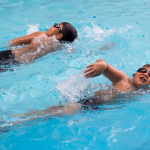Swimming Safely in the Sun: Expert Pediatric Guidance for Families
Swimming is a favorite summer activity for children, offering fun, exercise, and a way to cool off on hot days. However, swimming during sunny days comes with unique risks, especially for young children. At Altoona pediatric, our team is dedicated to helping families enjoy the water safely while protecting children’s health.
The Benefits of Swimming for Children
Swimming is not only enjoyable but also beneficial for children’s physical and mental development. It promotes cardiovascular health, builds muscle strength, and enhances coordination. For many families, swimming is a social activity that encourages teamwork and friendship. However, the joys of swimming must be balanced with awareness of potential risks, particularly when the sun is strong.
Sun Exposure and Swimming: What Parents Need to Know
When children swim outdoors, they are exposed to direct sunlight and reflected UV rays from the water. Even on cloudy days, up to 70% of UV light can penetrate, and water reflects about 5% of UV rays. This means that children are at risk of sunburn even when they are in the water. The redness, pain, and swelling of sunburn typically begin about four hours after exposure, peak at 24 hours, and start to improve after 48 hours. Most sunburns are first-degree burns, causing pink or red skin, but prolonged exposure can lead to blistering and second-degree burns. In rare cases, severe sunburn can cause third-degree burns or scarring.
Protecting Children from Sunburn While Swimming
To protect children from sunburn while swimming, parents should take several precautions:
- Apply broad-spectrum sunscreen with SPF 30 or higher to all exposed skin at least 30 minutes before swimming.
- Reapply sunscreen every two hours, or immediately after swimming or sweating.
- Dress children in UV-protective swimwear, such as rash guards and swim shirts.
- Use wide-brimmed hats and sunglasses to protect the face and eyes.
- Seek shade during peak sun hours (10 AM to 4 PM).
- Encourage frequent breaks in the shade to reduce overall sun exposure.
Special Considerations for Infants
Infants have especially delicate skin and are more vulnerable to sunburn. Our healthcare for infants specialists recommend keeping babies out of direct sunlight and avoiding swimming during peak UV hours. If swimming is necessary, use physical barriers like hats, lightweight clothing, and stroller canopies. Sunscreen is generally not recommended for infants under six months.
Recognizing and Treating Sunburn
Despite precautions, sunburn can still occur. If you suspect your child has been overexposed to the sun, start ibuprofen early—ideally as soon as you notice redness or discomfort. Ibuprofen can help reduce redness and swelling, but it is most effective when started before symptoms peak. The recommended dose is three times a day for two days.
If your child develops severe pain, large blisters (more than ½ inch or 12 mm), many small blisters, blisters on the face, swollen feet, or signs of infection (draining pus, red streaks, worsening pain after day two), contact your healthcare pediatric provider or schedule a pediatric appointment. For urgent concerns, our acute care pediatrics team is available to provide prompt evaluation and treatment.
Drowning Prevention and Water Safety
In addition to sun protection, water safety is a top priority. Always supervise children closely when they are in or near water. Teach children to swim and ensure they wear life jackets when appropriate. Our medical pediatric team can provide guidance on water safety and drowning prevention during routine visits.
The Role of Pediatric Care in Summer Safety
Regular visits with your medical pediatrics provider are an excellent opportunity to discuss sun safety, water safety, and overall summer health. Our associates in pediatrics and pediatrics health associates are here to support your family with expert advice and comprehensive care.
For urgent concerns, such as severe sunburn or water-related injuries, our same day sick appointments ensure your child receives timely care. And for other pediatric needs, such as pediatric ear piercing, PHCA Altoona offers safe, medical-grade services.
Additional Tips for Safe Swimming in the Sun
- Teach children to recognize the signs of sunburn and dehydration.
- Encourage frequent hydration with water or electrolyte drinks.
- Avoid swimming during peak UV hours whenever possible.
- Use swim diapers for infants and toddlers to maintain pool hygiene.
- Review pool rules and safety guidelines with children before swimming.
Conclusion
Swimming during sunny days can be a wonderful experience for children, but it requires careful attention to sun protection and water safety. By following these guidelines and partnering with your pediatric physician, you can ensure your child enjoys the water safely and healthily all summer long.







